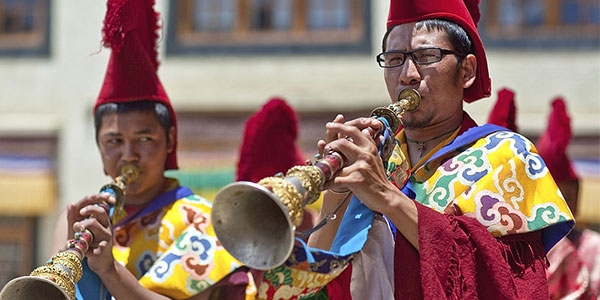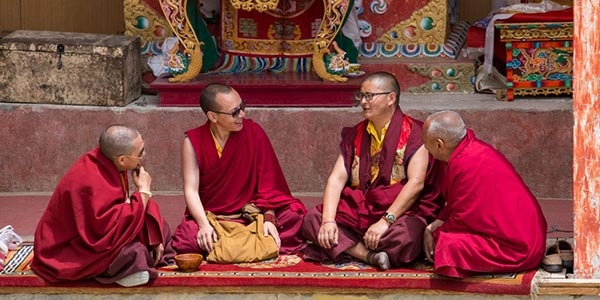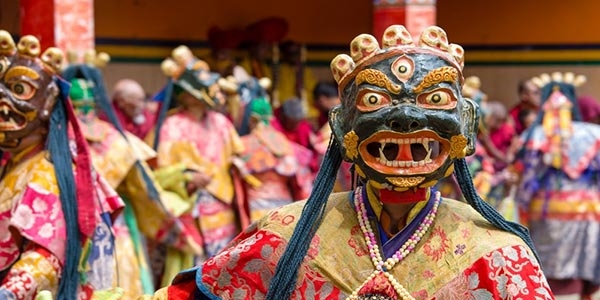Yuru Kabgyat Festival: Time, Significance, Mask Dance
 |
| Yuru Kabgyat is a 2-day festival, which is celebrated on the 17th and 18th day of the 5th Tibetan month. Photo IndiaTours |
What is the meaning of Yuru Kabgyat Festival?
Hosted in Ladakh for two days, YuruKabgyat is an important Buddhist festival. It is celebrated with great pomp and show at the historical Lamayuru Monastery. Devotees from all over the world, Lamas from Japan, Korea, Tibet, etc., arrive to attend the festivities.
The special attraction of the festival is the masked dances or chams performed by monks to keep evil spirits at bay. In a cham, monks adorn their faces with large vibrant masks and move around in circular motions to the beats of cymbals and drums. Gigantic pipes are played during the festivities and their soulful sounds echo throughout the valley, dousing the visitors is a sense of utmost calm and peace.
Prayer wheels scattered throughout the monastery are a delightful sight. This festival is a great opportunity to get insights into the intricacies of Buddhism and the teachings of Lord Buddha.
 |
| Photo IndiaTours |
When is Yuru Kabgyat Festival?
Yuru Kabgyat is a 2-day festival, which is celebrated on the 17th and 18th day of the 5th Tibetan month, which usually coincides in July. Lamayuru monastery serves as the venue for the event. This year it falls on June 7-8.
Significance Of Yuru Kabgyat Festival
The festival of YuruKabgyat is dedicated to the Yama and Padmasambhava. Yama is said to be the Lord of Death, whereas Padmasambhava is said to the second Buddha. Padmasambhava is also considered to be the protector of horses, stallions and other animals and creatures. He is also considered to be the Lord of wealth.
The main figures usually depicted in the dance drama are Yama (the Lord of Death) and Padmasambhava (the Second Buddha). He is considered to be the protector of the horses and animals and is also regarded as the Lord of Wealth. The festival concludes with sacrificial offerings and sacred rites performed.
Celebration of Yuru Kabgyat Festival: Mask dance
During the festival, Buddhist monks from all over the country dress up to celebrate the festival with great zeal and enthusiasm. The festival of YuruKabgyat is incomplete without Chams, which is a dance drama performed by the lamas and monks. They wear masks that are generally made of paper mache and also have plaster coating on it and then dance in circular motions. The dance movements of the monks and lamas compliment the sounds of the dungchen, cymbals and drums. As the YuruKabgyat festival comes to an end, the sacrificial offering is made and certain sacred rituals are performed by the monks.
 |
| Photo IndiaTours |
The festival of YuruKabgyat is a lifetime experience and is breathtaking. One can learn a lot about Buddhism and the teachings of Buddha from the festival. The mystical beauty of this festival is what attracts people from all over the world.
Buddhist Monks especially dress for the event to celebrate the festival with great fervour. Yuru Kabgyat is actually a dance drama, comprising of “Chhams”. In Chamm, the Lamas dance in a circle decorated with vibrant masks. These masks are generally made of paper Mache and have a thin quote of plaster encasing it. The circular dance movements are followed by the beats of the drums, cymbals and long pipes.
Being enacted at the pristine locations of Leh and Ladakh, the dance drama is the highlight of Yuru Kabgyat. Travellers visiting Ladakh can have the excellent opportunity to learn about the religion of Buddhism. The festival also offers wonderful opportunity to understand about the teachings of the Buddha that, adding more fame to the occasion.
**READ MORE: Who Is Beagle On The Masked Dancer: Theories, Judges, Host And Costumes
| Mask dances are the essential part of Buddhist festivals. Mahayana tradition is the most spectacular tradition that persists in Bhutan. Mask dance or Chham dance dates back to 8th century. It was performed for the first time during that century as part of holy scripts. The objective of mask dance is to placate the deity. It is also performed to evict the evil spirits and thus protect the people from epidemics and natural calamities. It ensures the health and hygiene of the people. Participation of monks at Lahaul, Spiti, Kinnaur and Ladakh make the mask dance performance worth witnessing and jolly experience. |
 When is Saga Dawa Festival: Significance, Celebrattion, Places to Visit and Why "The Poor’s Day' When is Saga Dawa Festival: Significance, Celebrattion, Places to Visit and Why "The Poor’s Day' Saga Dawa Festival is observed by Tibetan Buddhist as one of the important festival in their society. Read on to know its significance and activities ... |
 Shimla Summer Festival: When, Where and Activities to Celebrate Shimla Summer Festival: When, Where and Activities to Celebrate Shimla Summer Festival often starts with a huge gathering of tribal people, budding artists, and tourists to mark the advent of the summer season. This ... |
 12 Most Popular Festivals and Holidays in India During June 12 Most Popular Festivals and Holidays in India During June India is the place with plenty of festivals all over the year, and beautiful culture. Keep reading the article below for 12 Most Popular Festivals ... |



























